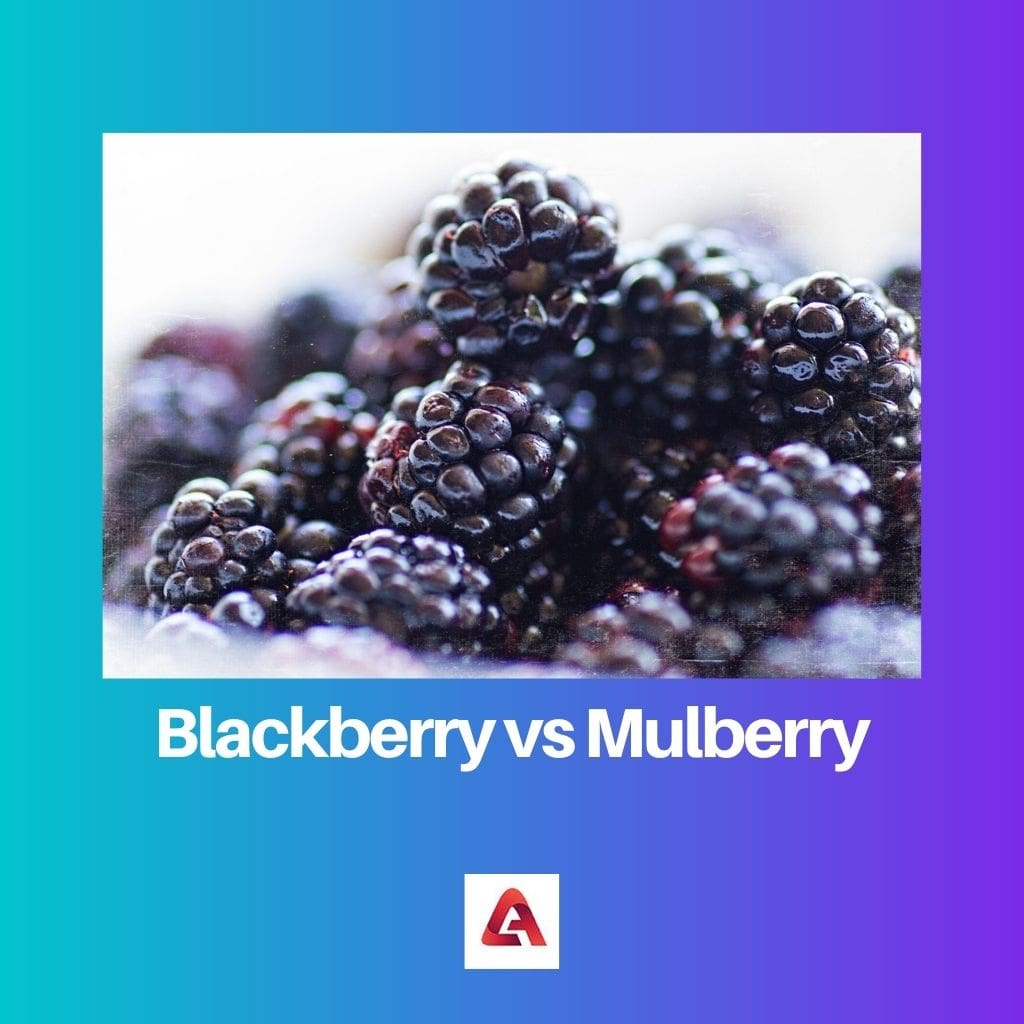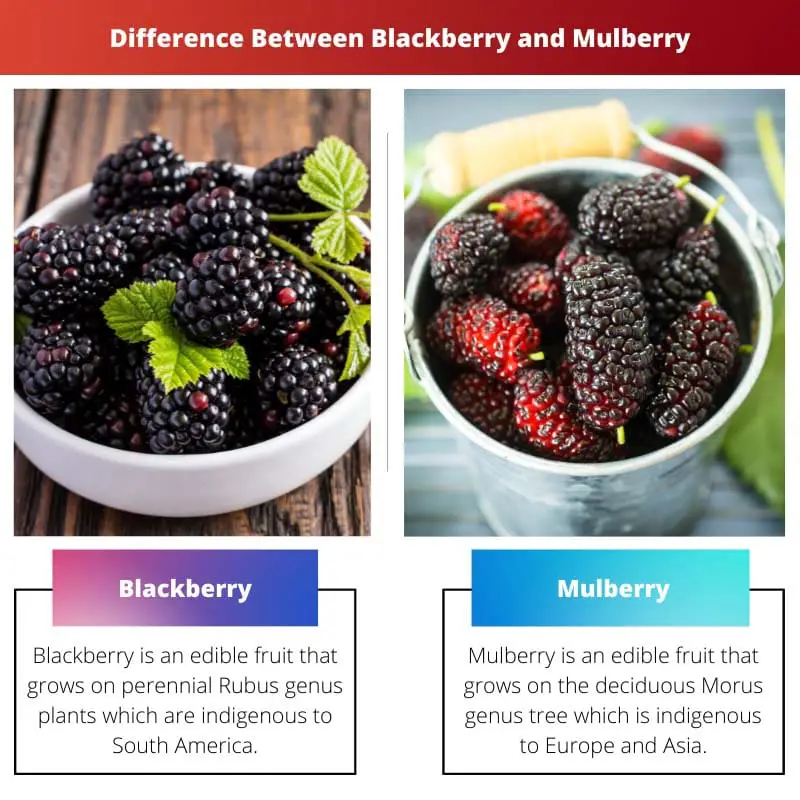According to various archaeological findings, humans domesticated fruit plants before domesticating animals. Black and mulberry are delicious fruits humans have been harvesting for centuries.
From the appearance, both of these fruits look the same. For this reason, many people confuse one with another.
However, they are entirely different types of fruit and come from different kinds of plants. Both of these fruits have lots of dissimilarities from each other.
A close observation makes the difference between these two fruits clear.
Key Takeaways
- Blackberries are aggregate fruits produced by plants in the Rubus genus, characterized by their dark purple or black color, sweet-tart flavor, and tiny, clustered drupelets.
- Mulberries are multiple fruits produced by plants in the Morus genus, with a similar appearance to blackberries but a sweeter taste and a range of colors, including red, purple, and white.
- Black and mulberries are nutritious fruits that can be enjoyed fresh, cooked, or preserved but differ in taste, texture, and botanical characteristics.
Blackberry vs Mulberry
A blackberry is a small, aggregate, round shaped edible fruit that is dark purple to black in color. It is grown on a bush or bramble. A mulberry is a colorful oval shaped berry that is can be eaten both fresh and dried. It is larger than a blueberry and grows on trees.

Comparison Table
| Parameter of Comparison | Blackberry | Mulberry |
|---|---|---|
| What is it | Blackberry is an edible fruit that grows on perennial Rubus genus plants, indigenous to South America. | Mulberry is an edible fruit that grows on the deciduous Morus genus tree, indigenous to Europe and Asia. |
| Size of the plant/tree | 3 to 4 feet tall and wide | 30 to 50 feet tall |
| colour | Dark purple to black colour | Red to dark purple colour |
| Shape | Round | Oval |
| Nutritional value/100 gram | 9.61 grams of Carbohydrates, 1.39 grams of protein, 4.88 grams of sugar, and 0.49 grams of fat. | 9.80 grams of Carbohydrates, 1.44 grams of protein, 8.10 grams of sugar, and 0.39 grams of fat. |
What is Blackberry?
Blackberry is an edible fruit that grows on perennial Rubus genus plants indigenous to South America. This fruit grows on bushes 3 to 4 feet tall and wide.
Farmers trim these plants to maximize berry harvest. The upper portion of this plant is biennial and grows multiple branches in the spring.
The berry farmers had to wait a year to get fruit from these branches. When ripped, the colour of blackberry turns dark purple, and later on, it turns black.
The shape of this fruit is completely round, and the size of this fruit remains in-between 1.5 cm to 2.5 centimetres long. This fruit is very juicy, but its juice contains no pigment.
For this reason, it does not keep any stain on the person who eats it raw. Along with fresh eating, this fruit is also used for jam, jelly, and other desserts.
In 100 grams or 3.5 ounces of blackberries, scientists found 9.61 grams of Carbohydrates, 1.39 grams of protein, 4.88 grams of sugar, and 0.49 grams of fat. It is also enriched with multiple vitamins like Vitamin A, B, K, C, and E.
Blackberries also contain high levels of natural minerals like Calcium, Phosphorus, Magnesium, and Potassium. This fruit is very good for health and has good immune-building properties.

What is Mulberry?
Mulberry is an edible fruit that grows on the deciduous Morus genus tree indigenous to Europe and Asia. Mulberry trees proliferate.
In nature, they grow 30 to 50 feet tall. However, most farmers trim them and keep their height under 25 feet.
Most farmers use Cultivar whips business level production. When mature, these trees can yield up to 300 kg of mulberry annually.
When ripped the colour of the mulberry turns into red colour, and later on, it turns into a dark purple colour. The shape of this fruit is a little oval, and the size of this fruit remains in-between 2 cm to 3 centimetres long.
Many people prefer to eat this fruit raw because it is very juicy. However, the juice of mulberry contains purple pigment.
Therefore, the colour of this fruit puts marks on clothes when it comes in contact. Along with raw eating, this fruit is used for different desserts and jams.
In 100 grams or 3.5 ounces, mulberry scientists found 9.80 grams of Carbohydrates, 1.44 grams of protein, 8.10 grams of sugar, and 0.39 grams of fat. It is also enriched with vitamins like Vitamins B, K, A, E, and C.
Blackberries also contain high levels of natural minerals like Calcium, Phosphorus, Magnesium, and Potassium. This fruit is very good for fitness and has skin rejuvenation properties.

Main Differences Between Blackberry and Mulberry
- Blackberry is an edible fruit that grows on perennial Rubus genus plants indigenous to South America. On the other hand, Mulberry is an edible fruit that grows on the deciduous Morus genus tree, which is indigenous to Europe and Asia.
- Blackberry is a bushy plant and grows only 3 to 4 feet tall and wide. However, mulberry grows on trees 30 to 50 feet tall.
- When ripped, blackberry becomes dark purple, and later on, it gets black colour. But, when pulled, mulberry becomes red, and later on, it becomes dark purple.
- The shape of the blackberry is round, while the mulberry has an oval shape.
- In 100 grams of blackberry, scientists found 9.61 grams of Carbohydrates, 1.39 grams of protein, 4.88s grams of sugar, and 0.49 grams of fat. On the other hand, in 100 grams of mulberry, scientists found 9.80 grams of Carbohydrates, 1.44 grams of protein, 8.10 grams of sugar, and 0.39 grams of fat.


I’ve always enjoyed eating blackberries and mulberries, and now I know why they taste so different from each other.
Yes, it’s amazing how nature creates such diverse and flavorful fruits.
I never knew about the distinct growth patterns of blackberries and mulberries. Interesting read.
Absolutely, understanding the growth habits of these fruits adds a new layer of appreciation for them.
This post is very informative and well-written. It’s good to know the differences between blackberries and mulberries.
I agree, it’s fascinating to learn about the botanical characteristics of both fruits.
Who would have thought that blackberries and mulberries have such distinct sizes and nutritional profiles? The diversity of nature is truly remarkable.
Absolutely, these details further emphasize the uniqueness of different fruits.
Nature’s diversity never ceases to amaze. It’s wonderful to learn about these varieties.
This detailed description of the blackberry and mulberry plants is quite enlightening. I appreciate the botanical insights.
This is a fascinating exploration of botanical features and nutritional values. It’s a delightful read.
I’m glad to have come across such an enriching post. It truly captures the essence of distinct fruits.
Absolutely, the depth of information here is commendable.
Fruit plants are incredibly fascinating. The nutritional values of blackberries and mulberries are impressive as well.
I think the comparison table provided here is very useful in understanding the key differences between blackberries and mulberries. Great work!
Absolutely, it’s always helpful to have a clear breakdown of the characteristics for better comprehension.
Indeed, this table provides a comprehensive view of the distinctions between the two fruits.
The visual comparison of these fruits is quite engaging, and the explanation of their nutritional content is impressive.
Indeed, the visual and scientific details combined make this post both visually appealing and intellectually stimulating.
Wow I didn’t know that! Humans domesticated fruit plants before domesticating animals! Very interesting.
Yes, that is surprising. I wonder what made them choose fruit plants over animals.